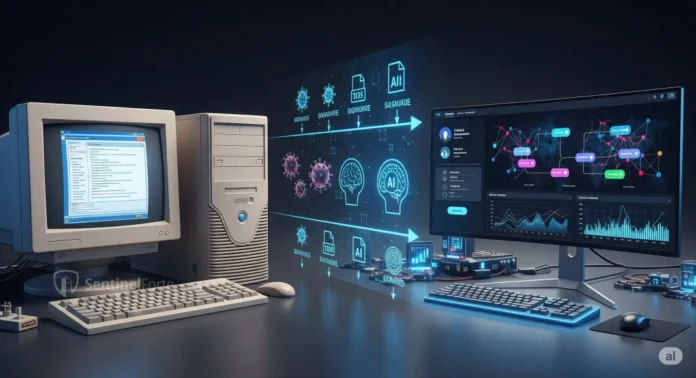The evolution of antivirus software from traditional signature-based detection to modern artificial intelligence (AI)-driven solutions marks a significant advancement in cybersecurity. As cyber threats have grown increasingly sophisticated, antivirus technologies have similarly evolved, shifting from static detection methods to dynamic, predictive systems capable of anticipating threats before they cause damage.
Imagine antivirus software as security guards protecting a digital fortress. Early guards had to recognize known intruders from mugshots, unable to defend against unknown attackers. Modern guards, however, employ advanced surveillance, recognizing suspicious behaviors and proactively intercepting threats. This analogy illustrates the transformation antivirus software has undergone in response to evolving cyber threats.
According to a 2024 cybersecurity market analysis by Gartner, the global antivirus industry has increasingly adopted AI-driven technologies, significantly enhancing threat detection accuracy and response times.
The Early Days: Signature-Based Detection
Initially, antivirus software primarily relied on signature-based detection methods. These programs used databases containing known virus signatures—distinctive codes uniquely identifying each malware. Whenever a file matched a known signature, antivirus software immediately quarantined or deleted it.
This approach worked effectively against known threats but faltered against new, unknown malware variants. Cybercriminals rapidly developed methods to bypass detection, prompting the antivirus industry to innovate beyond basic signature identification.
The Rise of Heuristic Analysis
To address limitations of signature-based methods, antivirus developers introduced heuristic analysis. Instead of relying solely on known signatures, heuristic techniques analyze behaviors and patterns indicative of malware. By identifying suspicious behavior patterns, heuristic analysis detects previously unseen threats based on their actions rather than specific codes.
However, heuristic methods brought their own challenges, primarily increased false positives—flagging benign activities mistakenly as threats. Antivirus companies thus faced the complex task of balancing sensitivity and accuracy.
The Advent of Behavioral Analysis
Behavioral analysis represented the next significant step, monitoring real-time activities of applications and processes. Antivirus software began identifying malicious actions based on behavior such as unauthorized file modifications, attempts to disable security controls, or suspicious network communications.
Behavioral analysis significantly improved malware detection capabilities, addressing threats more proactively. Yet, it still faced challenges distinguishing legitimate user activities from malicious intent, highlighting the need for even more sophisticated solutions.
Machine Learning and Antivirus Software
The integration of machine learning transformed antivirus technologies profoundly. Machine learning algorithms analyze vast datasets, learning to recognize patterns and anomalies autonomously. This allows antivirus software to predict and detect new malware variants without explicit programming or known signatures.
Leading cybersecurity firms such as Bitdefender, Norton, and McAfee began incorporating machine learning technologies, significantly enhancing detection accuracy and response speed. Machine learning enables antivirus systems to adapt dynamically to evolving threats, continuously refining threat recognition through ongoing data analysis.
The Era of Artificial Intelligence (AI)
AI-driven antivirus software represents the current peak of antivirus evolution. These advanced solutions use sophisticated neural networks capable of simulating human decision-making processes. AI systems detect, analyze, and respond to threats autonomously, significantly reducing human intervention and improving cybersecurity posture.
AI-driven antivirus technologies utilize predictive analytics, proactively identifying vulnerabilities and potential threats based on behavioral predictions. According to IBM’s Security Intelligence Report (2024), AI-driven antivirus systems can detect and neutralize emerging threats in real-time, achieving higher efficiency than traditional methods.
Real-world Applications of AI-Driven Antivirus
AI-driven antivirus software is increasingly implemented across various sectors, providing essential protection against sophisticated cyberattacks. In finance and healthcare industries, AI-driven antivirus solutions protect critical infrastructure, safeguard sensitive data, and ensure regulatory compliance.
In corporate environments, AI systems continuously monitor network traffic, identify unusual patterns, and instantly quarantine threats, significantly minimizing downtime and business disruptions.
Benefits and Challenges of AI-Driven Antivirus
AI-driven antivirus software offers numerous advantages:
- Enhanced Detection: Proactive threat detection even against zero-day attacks.
- Reduced False Positives: Improved accuracy reduces interruptions caused by misidentified threats.
- Autonomous Response: Faster response times without extensive human intervention.
However, AI-driven antivirus also faces challenges, including potential biases in machine learning datasets, resource intensity, and reliance on extensive computational power.
Future Directions for Antivirus Technology
As cyber threats continue evolving, antivirus software will increasingly rely on advanced AI models, leveraging deep learning and predictive analytics further. Integrating AI with cloud-based threat intelligence and endpoint detection and response (EDR) solutions is likely to enhance overall cybersecurity resilience significantly.
Antivirus technologies may soon incorporate quantum computing to process vast data volumes swiftly, providing even more robust cybersecurity frameworks capable of neutralizing emerging cyber threats instantly.
The evolution from signature-based antivirus solutions to AI-driven technologies demonstrates a continuous commitment to adapting cybersecurity strategies to emerging threats. Leveraging advanced AI techniques ensures robust, proactive protection, marking the future direction of cybersecurity and antivirus software development.
Understanding and embracing these technological advancements is critical to maintaining secure digital environments amidst an increasingly complex cyber threat landscape.

